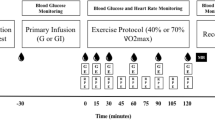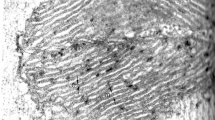Abstract
The possible role of acetate in the genesis of exercise hyperemia was studied in five series of dogs. Intraarterial infusion of an isomotic solution of sodium acetate at 0.76 ml/min in the dog forelimb decreased the resistance to flow through skeletal muscle by 48%, primarily by decreasing resistance to flow through small vessels. Skin lymph flow and lymph protein concentration were unaffected. The hindlimb of the conscious dog took up acetate at rest (A-V difference, _58.3±19.6 nmoles/ml) and put out acetate during treadmill exercise (A-V difference, −105.6±20.12 nmoles/ml); femoral venous blood acetate concentration increased by 145 nmoles/ml (control 195 nmoles/ml). In the gracilis muscle of the anesthetized dog, simulated exercise at 0.5, 1.0 or 2.0 Hz increased acetate tissue content (72, 248 and 442 nmoles/g, respectively), output (18,899, and 1,830 nmoles/100 g/min, respectively) and venous cencentration (82, 49 and 39 nmoles/ml, respectively) and changes in tissue acetate content correlated with changes in vascular resistancer=0.75,P<0.001. Intraarterial infusion of an isosmotic solution of sodium acetate in the quiescent gracilis muscle perfused at constant flow produced a significant (6%) decrease in resistance when arterial blood acetate was increased by a calculated 96 nmoles/ml. These studies suggest that acetate might be included among those metabolites that contribute to exercise hyperemia.
Similar content being viewed by others
References
Arturson G, Kjellmer I (1964) Capillary permeability in skeletal muscle during rest and activity. Acta Physiol Scand 62: 41–45
Bacchus A, Gamble G, Haddy F, Scott J (1979) Role of inorganic phosphate in active hyperemia in skeletal muscle. Proc Soc Exp Biol Med 161: 13–17
Ballard FJ (1972) Supply and utilization of acetate in mammals. Am J Clin Nutr 25: 773–779
Bernson VSM, Nicholls DG (1974) Acetate, a major end product of fatty-acid oxidation in hamster-brown-adipose tissue mitochondria. Eur J Biochem 47: 517–525
Grega GJ, Kline RL, Dobbins DE, Haddy FJ (1972) Mechanisms of edema formation by histamine administered locally into aanine forelimb. Am J Physiol 223: 1165–1171
Haddy FJ, Scott JB (1968) Metabolically linked vasoactive chemicals in local regulation of blood flow. Physiol Rev 48: 688–707
Haddy FJ, Scott JB (1975) Metabolic factors in peripheral circulatory regulation. Fed Proc 34: 2006–2011
Haddy FJ, Scott JB (1975) Active hyperemia, reactive hyperemia, and autoregulation of blood flow. In: Kaley G, Altura BM (eds) Microcirculation, vol 3. Univ Park Press. Baltimore, pp 531–544
Haddy FJ, Molnar JI, Borden CW, Texter EC Jr (1962) Comparison of direct effects of angiotensin and other vasoactive agents on small and large blood vessels in several vascular beds. Circulation 25: 239–246
Haddy FJ, Scott JB, Grega GJ (1972) Effects of histamine on lymph protein concentration and flow in the dog forelimb. Am J Physiol 223: 1172–1173
Hirche H, Schumacher E, Hagemann H (1980) Extracellular K+ concentration and K+ balance of gastroenemicus muscle of the dog during exercise. Pflügers Arch 387: 231–237
Honig CR, Frierson JL (1980) Role of adenosine in exercise vasodilation in dog gracilis muscle. Am J Physiol 238: H703-H715
Kirkendol PL, Pearson JE, Bower JD, Hollbert RD (1978) Myocardial depressent effects of sodium acetate. Cardiovascular Res 12: 127–136
Knowles SE, Jarrett IG, Filsell OH, Ballard FJ (1974) Production and utilization of acetate in mammals. Biochem J 142: 401–411
Kvein M, Nesbakken R, Bredesen JE (1979) Plasma acetate concentrations during canine haemorrhagic shock. Scand J Clin Lab Invest 39: 645–652
Liang CS, Lowenstein JM (1978) Metabolic control of the circulation: Effects of acetate and pyruvate. J Clin Invest 62: 1029–1038
Ludquist F (1962) Production and utilization of free acetate in man. Nature 193: 579–580
Mayfield ED, Bensadoun A, Johnson BC (1966) Acetate metabolism in ruminant tissues. J Nutr 89: 189–196
Molnar JI, Scott JB, Frohlich ED, Haddy FJ (1962) Local effects of various anions and H+ on dog limb and coronary vascular resistances. Am J Physiol 203: 125–132
Nagle FJ, Scott JB, Swindall BT, Haddy FJ (1968) Venous resistances in skeletal muscle and skin during local blood flow regulation. Am J Physiol 214: 885–891
Olinger GN, Werner PH, Bronchek LI, Boerboom LE (1979) Vasodilator effects of the sodium acetate in pooled protein fraction. Ann Surg 190: 305–311
Skuthches CL, Holroyde CP, Meyers RN, Paul P, Reichard GA (1979) Plasma acetate turnover and oxidation. J Clin Invest 64: 708–713
Tollinger CD, Vreman HJ, Weiner MV (1979) Measurement of acetate in human blood gas chromatography: Effects of sample preparation, feeding and various diseases. Clin Chem 25: 1787–1790
Waddell WJ (1956) A simple ultraviolet spectrophotometric method for the determination of protein. J Lab Clin Med 48: 311–314
Author information
Authors and Affiliations
Additional information
Supported by grants CO7610 and CO7635 from the Uniformed Services University. Preliminary communications included Physiologist 21:115, 1978, Federation Procedings 39:270, 1980 and Physiologist 23:156, 1980
Rights and permissions
About this article
Cite this article
Steffen, R.P., McKenzie, J.E. & Haddy, F.J. The possible role of acetate in exercise hyperemia in dog skeletal muscle. Pflugers Arch. 392, 315–321 (1982). https://doi.org/10.1007/BF00581625
Received:
Accepted:
Issue Date:
DOI: https://doi.org/10.1007/BF00581625




